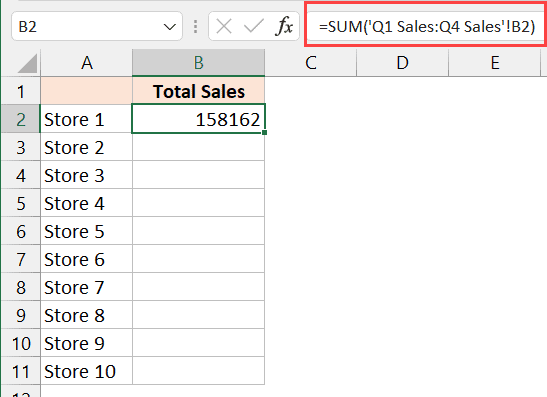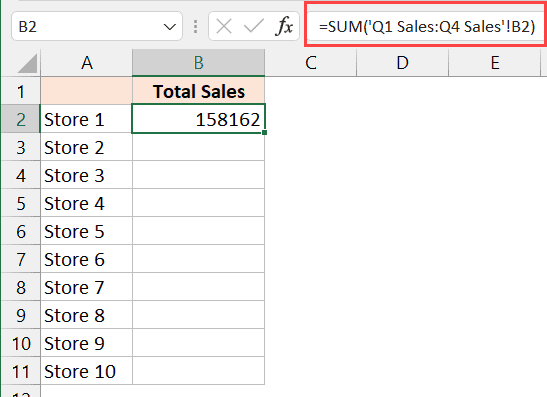Mastering Excel: Calculate Totals Across Multiple Sheets Easily

Introduction to Calculating Totals Across Multiple Sheets

Excel is a robust tool used globally by individuals and businesses alike to manage, analyze, and organize vast amounts of data. One of its most powerful features is the ability to perform calculations across multiple sheets within the same workbook. This capability not only saves time but also reduces errors when dealing with complex datasets. In this post, we’ll delve into how you can calculate totals across multiple sheets in Excel, ensuring you can harness the full potential of this software for your data management needs.

Understanding Excel Sheets and Workbooks

Before we dive into complex calculations, let’s clarify the structure of an Excel workbook:
- Workbook: This is the entire Excel file which can contain one or many sheets.
- Sheet: Each workbook is made up of sheets, which can be thought of as individual pages within the file.
Basic Steps to Calculate Totals

Calculating totals across sheets requires an understanding of a few key Excel features:
- 3D References: These allow you to reference data across multiple sheets simultaneously.
- Consolidation: A tool that helps in combining data from several ranges into one.
Method 1: Using 3D References

3D references are like a special kind of cell reference that lets Excel look across sheets. Here’s how you can use them:
- Ensure your data is formatted consistently across all sheets where you want to calculate totals.
- Go to the sheet where you want to display the total.
- Click into the cell where you want the total to appear.
- Type the equal sign (=) to start your formula.
- Click on the tab of the first sheet and select the range of cells that contains the data.
- Hold the Shift key and click on the last sheet tab where you want to include data. Excel will automatically include the sheets in between.
- Release the Shift key, and Excel will expand the formula to something like:
=SUM(Sheet1:Sheet3!A1:A10). - Press Enter to complete the formula.
🗒 Note: All sheets must be of the same structure for this method to work effectively. If your sheets have different layouts, consider another approach.
Method 2: Using Consolidation

Excel’s Consolidate function provides an alternative way to aggregate data from multiple sheets:
- Select a blank cell where you want to display the consolidated data.
- Go to the Data tab and click on Consolidate from the Data Tools group.
- In the Function box, select the desired function (e.g., SUM).
- Under the References box, add the ranges from each sheet you want to include. You can type them in manually or click the sheet tabs to add them.
- Set any options like using labels, creating links to source data, or handling duplicate labels.
- Click OK to complete the consolidation.
Excel will then display a summary of the selected ranges, providing a total for each set of data across the sheets.
Advanced Scenarios

Conditional Summation

Using 3D references, you can also sum based on conditions:
- Type your formula with conditions, like
=SUMIF(Sheet1:Sheet3!A1:A10, “>100”)for summing values greater than 100. - Ensure that all sheets follow the same data structure and naming conventions.
Dynamic Totals with Macros

For more sophisticated calculations or frequent updates, you might consider using VBA (Visual Basic for Applications) to automate the process:
- Open the VBA editor with Alt+F11.
- Insert a new module and write a macro to loop through sheets and sum the required cells.
💡 Note: Macros require knowledge of VBA scripting and can introduce security risks if not managed properly.
Final Thoughts

Calculating totals across multiple sheets in Excel is a powerful feature that simplifies data analysis. Whether through straightforward 3D references, the consolidation tool, or more advanced techniques like VBA, you can efficiently manage and summarize data from various sources. This ability not only improves productivity but also allows for more insightful data analysis by providing a consolidated view of your data across multiple spreadsheets. As Excel continues to evolve, its capabilities for cross-sheet calculations will undoubtedly expand, further enhancing its utility for data-centric tasks.
What is the main difference between 3D references and consolidation?

+
The main difference lies in their functionality: 3D references provide a formulaic approach to sum data from multiple sheets with the same structure, while consolidation offers a more flexible tool for combining data from different ranges with different layouts.
Can I use conditional formulas across multiple sheets?

+
Yes, using 3D references with conditional formulas like SUMIF or SUMIFS allows you to sum data based on conditions across multiple sheets.
Is there a limit to how many sheets I can include in a 3D reference?

+
While there’s no explicit limit set by Excel for 3D references, the practical limit is influenced by workbook size, memory, and performance issues when dealing with extremely large datasets.